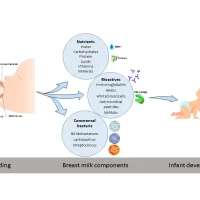Could forceful let-down be the root of the issue?
Does your baby exhibit any of these behaviors during breastfeeding?
- Choking or struggling: Gagging, choking, gasping, or coughing as if the milk flow is too rapid.
- Frequent unlatching: Repeatedly pulling away from the breast during feeds.
- Nipple clamping: Biting down on the nipple to slow the forceful milk flow triggered by let-down.
- Clicking sounds: Audible clicking noises while nursing.
- Digestive discomfort: Frequent spit-ups, excessive gas, or apparent reflux.
- Breast refusal: Occasional reluctance to nurse despite hunger.
- Discomfort with non-nutritive sucking: Resistance to comfort nursing outside of feeding times.
If these scenarios resonate with your experience, you might be dealing with forceful let-down, which is often linked to oversupply (excessive milk production). For some mothers, challenges with fast milk flow or oversupply become noticeable only after 3–6 weeks postpartum. The severity of forceful let-down varies widely—it may present as a minor inconvenience or escalate into a significant hurdle, depending on its intensity and its impact on the breastfeeding relationship.
Managing Forceful Let-Down: Key Strategies
To address forceful let-down, focus on two interconnected approaches: helping your baby manage rapid milk flow and gradually adapting your milk production to your baby’s needs. Since forceful let-down often stems from oversupply, combining these strategies is typically essential for effective resolution. Adjustments to reduce oversupply may take several weeks to yield noticeable results, so patience and consistent effort are critical during this process.
Managing Rapid Milk Flow During Breastfeeding
To help your baby handle a fast milk flow, consider these strategies:
Adjust Positioning
Position your baby at an upward angle relative to your breast, allowing gravity to slow the milk’s flow. Focus on positions where your baby’s head and throat remain above the nipple level. Effective options include:
- Reclined cradle hold: Lean back in a chair or use pillows for support.
- Reclined football hold: Position your baby under your arm while leaning back.
- Sitting upright: Have your baby face you in a seated position (ideal for public settings).
- Side-lying: Let excess milk dribble from your baby’s mouth during fast let-down.
- Laid-back (tummy-to-tummy): Recline comfortably with your baby lying face-down on your chest.
Frequent Burping
If your baby swallows air due to rapid feeding, pause periodically to burp them.
Optimize Feeding Frequency
Nurse more often to reduce milk accumulation between sessions, making feeds easier for your baby to manage.
Timing Matters
Feed when your baby is sleepy and relaxed, as gentler sucking naturally slows milk flow.
Manage Let-Down
After the initial let-down, briefly remove your baby and let the forceful spray subside into a towel. Re-latch once the flow eases.
Express Milk Cautiously
If other methods fail, pump or hand-express briefly before nursing to reduce flow. Gradually decrease the amount expressed to avoid stimulating oversupply.
Adapting Milk Supply to Your Baby’s Needs
Avoid Early Reductions
Refrain from attempting to decrease milk production during the first 4–6 weeks postpartum. During this critical period, milk supply naturally surges, and even a typical flow or let-down might temporarily overwhelm a newborn.
Tailor Nursing Based on Weight Gain
If your baby is gaining weight rapidly, nursing from one breast per feeding may help balance supply. However, if weight gain is slow, consult a lactation specialist before adjusting your supply.
Block Feeding Basics
This method reduces oversupply without restricting feeding frequency. After your baby finishes nursing on one breast, offer the same side again if they seek more milk. If the other breast becomes uncomfortably full, express minimal milk for relief, gradually reducing the amount expressed over time. Apply cool compresses (30 minutes on, 1 hour off) between feeds to ease discomfort and slow production.
Monitor Block Feeding Closely
If no improvement occurs within a week, seek professional guidance. Overuse of block feeding risks oversupply dropping too low. Always prioritize your baby’s feeding cues—return them to the same breast during a feeding window. For detailed protocols, refer to resources by experts like Nancy Mohrbacher, IBCLC.
Alternative Strategies
- Frequent Side Switching: Alternate breasts more often during a single feed to regulate flow.
- Full Drainage & Block Feeding (FDBF): Begin by fully emptying both breasts (via pumping), then follow a structured block-feeding schedule (e.g., 3 hours per side).
- Watch for Complications: Stay vigilant for plugged ducts or mastitis, especially during reduced feeding frequency.
Minimize Stimulation
Avoid unnecessary pumping, prolonged water flow on breasts (e.g., long showers), or breast shells. Reserve extreme measures like cabbage leaf compresses or herbal supplements for severe, persistent oversupply.
Natural Adjustments Over Time
Many mothers notice a gradual reduction in oversupply and forceful let-down around 12 weeks as hormonal shifts stabilize production. By this stage, supply often aligns more closely with baby’s needs.
Flow Transition Challenges
Babies accustomed to rapid flow may resist slower let-down as it naturally matures (typically between 3 weeks and 3 months). Even a normal flow can feel sluggish to them. For guidance, explore resources on managing perceived slow let-down.




